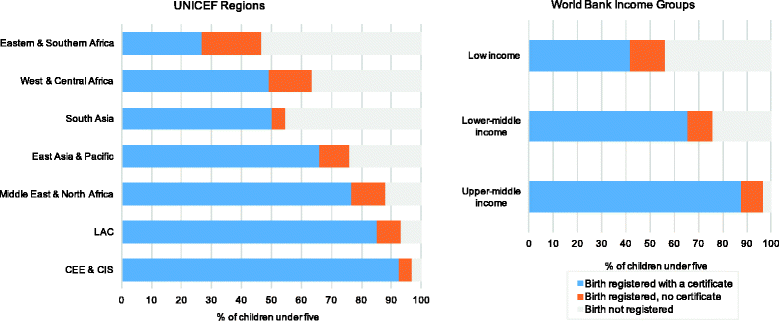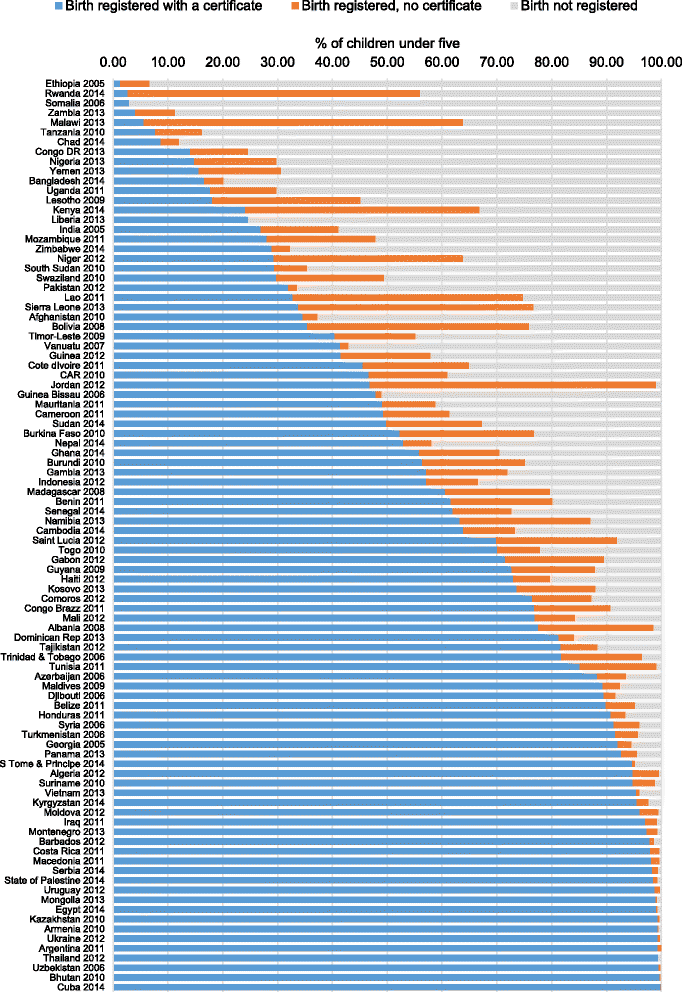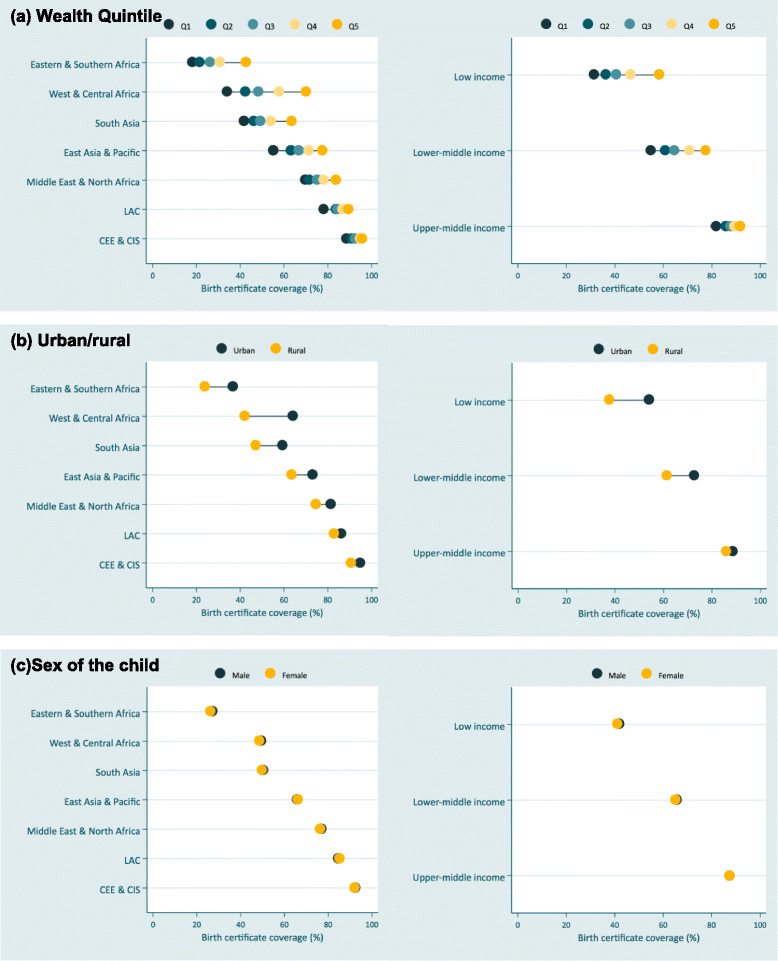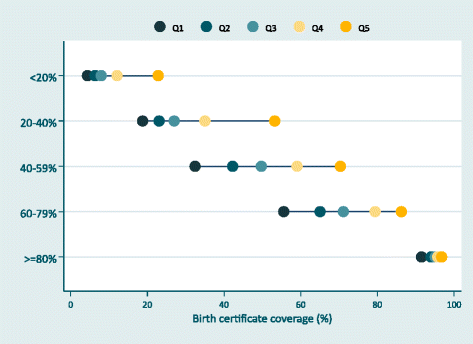Who and where are the uncounted children? Inequalities in birth certificate coverage among children under five years in 94 countries using nationally representative household surveys
- PMID: 28821291
- PMCID: PMC5562988
- DOI: 10.1186/s12939-017-0635-6
Who and where are the uncounted children? Inequalities in birth certificate coverage among children under five years in 94 countries using nationally representative household surveys
Abstract
Background: Birth registration, and the possession of a birth certificate as proof of registration, has long been recognized as a fundamental human right. Data from a functioning civil registration and vital statistics (CRVS) system allows governments to benefit from accurate and universal data on birth and death rates. However, access to birth certificates remains challenging and unequal in many low and middle-income countries. This paper examines wealth, urban/rural and gender inequalities in birth certificate coverage.
Methods: We analyzed nationally representative household surveys from 94 countries between 2000 and 2014 using Demographic Health Surveys and Multiple Indicator Cluster Surveys. Birth certificate coverage among children under five was examined at the national and regional level. Absolute measures of inequality were used to measure inequalities in birth certificate coverage by wealth quintile, urban/rural residence and sex of the child.
Results: Over four million children were included in the analysis. Birth certificate coverage was over 90% in 29 countries and below 50% in 36 countries, indicating that more than half the children under five surveyed in these countries did not have a birth certificate. Eastern & Southern Africa had the lowest average birth certificate coverage (26.9%) with important variability among countries. Significant wealth inequalities in birth certificate coverage were observed in 74 countries and in most UNICEF regions, and urban/rural inequalities were present in 60 countries. Differences in birth certificate coverage between girls and boys tended to be small.
Conclusions: We show that wealth and urban/rural inequalities in birth certificate coverage persist in most low and middle income countries, including countries where national birth certificate coverage is between 60 and 80%. Weak CRVS systems, particularly in South Asia and Africa lead rural and poor children to be systematically excluded from the benefits tied to a birth certificate, and prevent these children from being counted in national health data. Greater funding and attention is needed to strengthen CRVS systems and equity analyses should inform such efforts, especially as data needs for the Sustainable Development Goals expand. Monitoring disaggregated data on birth certificate coverage is essential to reducing inequalities in who is counted and registered. Strengthening CRVS systems can enable a child's right to identity, improve health data and promote equity.
Keywords: Birth certificates; Child health surveys; Global health; Health equity; Socioeconomic factors; Vital statistics.
Conflict of interest statement
Ethics approval and consent to participate
Ethical approval was the responsibility of the institution that conducted or commissioned the survey. All datasets used in this paper were de-identified.
Consent for publication
Not applicable.
Competing interests
The authors declare that they have no competing interests.
Publisher’s Note
Springer Nature remains neutral with regard to jurisdictional claims in published maps and institutional affiliations.
Figures




Similar articles
-
A missed opportunity: birth registration coverage is lagging behind Bacillus Calmette-Guérin (BCG) immunization coverage and maternal health services utilization in low- and lower middle-income countries.J Health Popul Nutr. 2019 Oct 18;38(Suppl 1):25. doi: 10.1186/s41043-019-0183-3. J Health Popul Nutr. 2019. PMID: 31627761 Free PMC article.
-
Changes and inequalities in early birth registration and childhood care and education in Vietnam: findings from the Multiple Indicator Cluster Surveys, 2006 and 2011.Glob Health Action. 2016 Feb 29;9:29470. doi: 10.3402/gha.v9.29470. eCollection 2016. Glob Health Action. 2016. PMID: 26950564 Free PMC article.
-
Going deeper with health equity measurement: how much more can surveys reveal about inequalities in health intervention coverage and mortality in Zambia?Int J Equity Health. 2023 Jun 2;22(1):109. doi: 10.1186/s12939-023-01901-x. Int J Equity Health. 2023. PMID: 37268969 Free PMC article.
-
Measuring coverage in MNCH: determining and interpreting inequalities in coverage of maternal, newborn, and child health interventions.PLoS Med. 2013;10(5):e1001390. doi: 10.1371/journal.pmed.1001390. Epub 2013 May 7. PLoS Med. 2013. PMID: 23667332 Free PMC article. Review.
-
The Minderoo-Monaco Commission on Plastics and Human Health.Ann Glob Health. 2023 Mar 21;89(1):23. doi: 10.5334/aogh.4056. eCollection 2023. Ann Glob Health. 2023. PMID: 36969097 Free PMC article. Review.
Cited by
-
Status and associated factors of birth registration in selected districts of Tigray region, Ethiopia.BMC Int Health Hum Rights. 2020 Jul 29;20(1):20. doi: 10.1186/s12914-020-00235-x. BMC Int Health Hum Rights. 2020. PMID: 32727474 Free PMC article.
-
Strategic yet delicate: the dilemma of involving health workers in facilitating birth registration in Indonesia.BMC Health Serv Res. 2019 Nov 26;19(1):889. doi: 10.1186/s12913-019-4594-z. BMC Health Serv Res. 2019. PMID: 31771565 Free PMC article.
-
Transgender data collection in the electronic health record: Current concepts and issues.J Am Med Inform Assoc. 2022 Jan 12;29(2):271-284. doi: 10.1093/jamia/ocab136. J Am Med Inform Assoc. 2022. PMID: 34486655 Free PMC article.
-
Towards an appropriate ethics framework for Health and Demographic Surveillance Systems (HDSS): learning from issues faced in diverse HDSS in sub-Saharan Africa.BMJ Glob Health. 2021 Jan;6(1):e004008. doi: 10.1136/bmjgh-2020-004008. BMJ Glob Health. 2021. PMID: 33408190 Free PMC article.
-
Prevalence and determinants of death registration and certification uptake in Uganda.PLoS One. 2022 Mar 4;17(3):e0264742. doi: 10.1371/journal.pone.0264742. eCollection 2022. PLoS One. 2022. PMID: 35245336 Free PMC article.
References
-
- Dunning C, Gelb A, Raghavan S. Birth Registration, Legal Identity, and the Post-2015 Agenda. Washington, DC: Center for Global Development; 2014.
-
- Plan International . Count every child: the right to birth registration. 2009.
-
- World Bank and WHO, Global Civil Registration and Vital Statistics. Scaling up investment plan 2015-2024. p. 2014.
-
- United Nations . The convention on the rights of the child. 1990. - PubMed
-
- United Nations News Service. UN News - UN lauds Somalia as country ratifies landmark children’s rights treaty. 2015. http://www.un.org/apps/news/story.asp?NewsID=49845#.WT7bhBPyuRs. Accessed 12 Jun 2017.
MeSH terms
Grants and funding
LinkOut - more resources
Full Text Sources
Other Literature Sources

